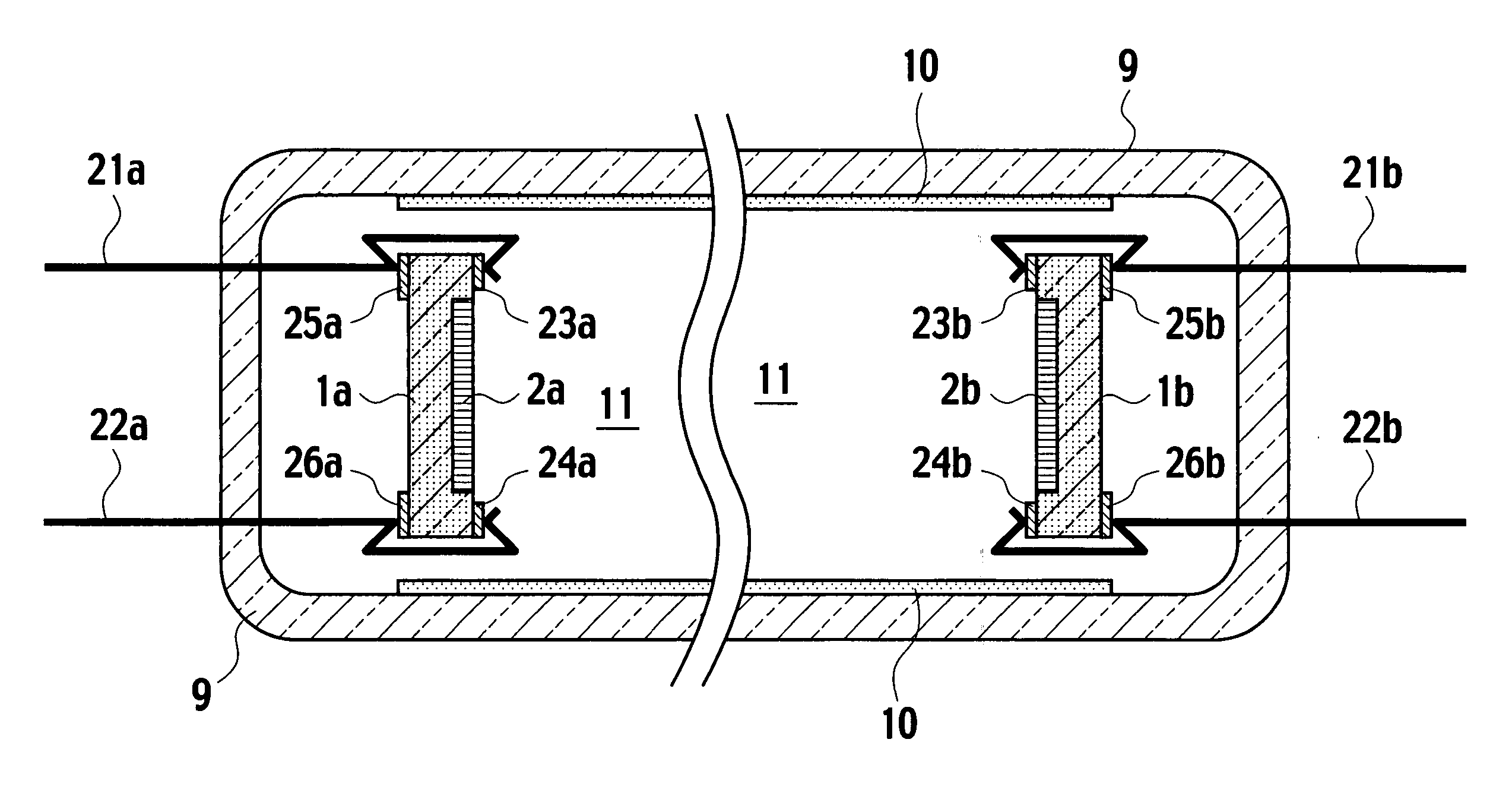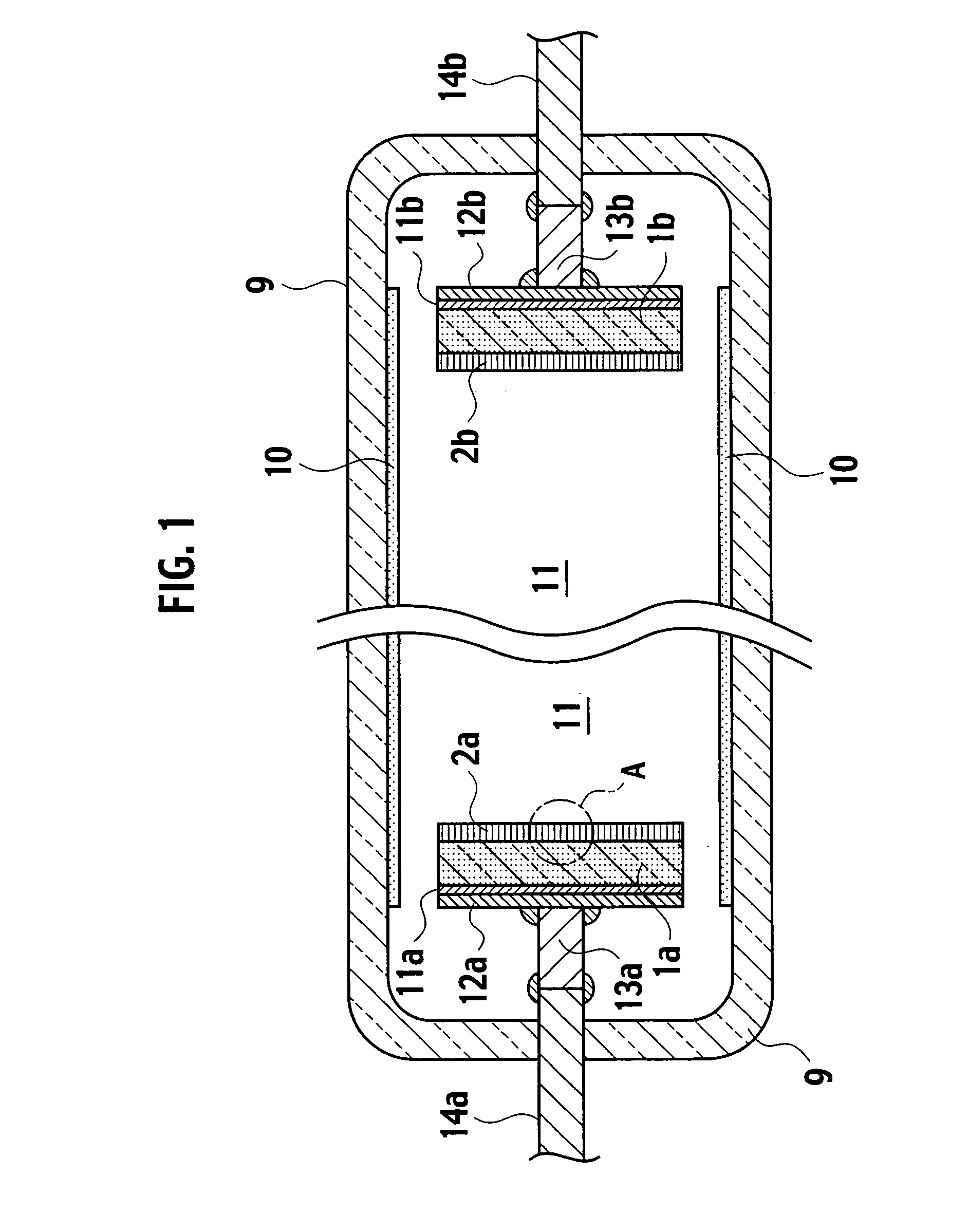Discharge electrode and discharge lamp
a discharge lamp and discharge electrode technology, applied in the manufacture of discharge tube/lamps, discharge tube main electrodes, electrode systems, etc., can solve the problems of not always showing sufficient improvement in efficiency, the majority of supplied electric power is consumed, and the relative less efficiency of thermal types, etc., to achieve high efficiency secondary-electron emission and long life
- Summary
- Abstract
- Description
- Claims
- Application Information
AI Technical Summary
Benefits of technology
Problems solved by technology
Method used
Image
Examples
first embodiment
[0040] As shown in FIG. 1, a discharge lamp according to a first embodiment of the present invention encompasses a sealed-off tube 9 filled with a discharge gas 11, a fluorescent film 10, which is coated with a thickness of 50 μm to 300 μm to part of the inner wall of the sealed-off tube 9, and a pair of discharge electrodes (2a, 1a, 11a, 12a; 2b, 1b, 11b, 12b), which is provided in the inside of the sealed-off tube 9 at both sides. The sealed-off tube 9 may be a glass tube made of soda lime glass, boron silicate glass or the like, for example.
[0041] Of the pair of discharge electrodes (2a, 1a, 11a, 12a; 2b, 1b, 11b, 12b), a first discharge electrode (2a, 1a, 11a, 12a) on the left side of FIG. 1 encompasses a wide bandgap semiconductor substrate 1a as a “supporting base”, an electron-emitting layer 2a formed as an emitter at the top surface of the wide bandgap semiconductor substrate (supporting base) 1a, a bottom electrode 11a formed on the bottom surface of the wide bandgap semic...
second embodiment
[0075]FIG. 9 is a fragmentary bird's eye view illustrating part of an electron-emitting layer 2a provided in a first discharge electrode of a discharge lamp, according to a second embodiment of the present invention, in which a part corresponding to portion A of FIG. 1 is enlarged. In the first discharge electrode of the discharge lamp, according to the second embodiment, a cathode base plate implemented by a wide bandgap semiconductor substrate1 made of diamonds, for example, has a plurality of fine pores Hi−1,j, . . . , Hi,j, . . . , Hi+2,j, . . . , which have sidewalls (vertical sidewalls) roughly parallel to electric fields perpendicular to the primary surfaces of the first discharge electrode. Dangling bonds on the surfaces of respective sidewalls (vertical sidewalls) of the fine pores Hi−1,j, . . . , Hi,j, . . . , Hi+2,j, . . . are subjected to hydrogen-termination treatment. Since the rest of the configuration of the discharge lamp is effectively the same as that of the disch...
third embodiment
[0087]FIG. 12 is a fragmentary bird's eye view illustrating part of an electron-emitting layer 2a in a first discharge electrode of a discharge lamp, according to the third embodiment of the present invention, which may corresponds to portion A in FIG. 1. The electron-emitting layer 2a is formed of a wide bandgap semiconductor and provided on a supporting base 45. The electron-emitting layer 2a is implemented by a plurality of protrusions, at least part of the surface of each of the protrusions is unseen from a perpendicular direction to a top surface of the electron-emitting layer 2a above the top surface of the electron-emitting layer 2a. As shown in FIG. 12, the protrusions are implemented by a plurality of wide bandgap semiconductor grains 4, each having a diameter “d”, agglomerated on the supporting base 45. Bonds of hydrogen atoms 3 terminate the dangling bonds on surfaces of respective wide bandgap semiconductor grains 4.
[0088] Diameter “d” of the respective wide bandgap sem...
PUM
 Login to View More
Login to View More Abstract
Description
Claims
Application Information
 Login to View More
Login to View More - R&D
- Intellectual Property
- Life Sciences
- Materials
- Tech Scout
- Unparalleled Data Quality
- Higher Quality Content
- 60% Fewer Hallucinations
Browse by: Latest US Patents, China's latest patents, Technical Efficacy Thesaurus, Application Domain, Technology Topic, Popular Technical Reports.
© 2025 PatSnap. All rights reserved.Legal|Privacy policy|Modern Slavery Act Transparency Statement|Sitemap|About US| Contact US: help@patsnap.com



